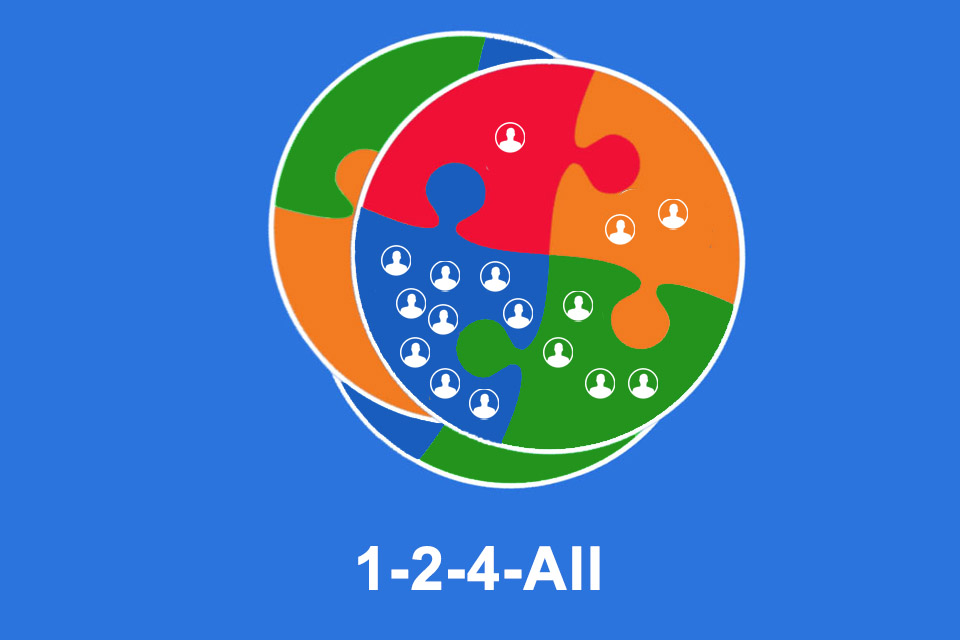What is 1-2-4-All?
Smartpedia: 1-2-4-All is a structured brainstorming format that gradually increases the number of participants per round.
1-2-4-All – brainstorming with structure
1-2-4-All – sometimes also referred to as the snowball method – belongs to the pool of so-called Liberating Structures¹. These currently comprise 33 microstructures with which the US American Keith McCandless and the Frenchman Henri Lipmanowicz aim to break down conventional structures in organisations and improve cooperation, communication and the commitment of those involved.
1-2-4-All is a structured brainstorming format. Brainstorming is a creativity technique in which a group of people try to solve a task or problem by brainstorming together and then evaluating ideas. However, brainstorming is relatively unstructured. This is where 1-2-4-All comes in. Round by round, the number of participants in brainstorming is increased. First, each person thinks individually about a centrally posed question (1), then two people discuss their ideas in dialogue (2). This is followed by a round with 4 participants (4) and finally an exchange between all participants (All).
1-2-4-All process and findings
The process of 1-2-4-All follows directly from the name of the method:
- 1 person,
- 2 persons,
- 4 persons and finally
- all persons
discuss one question.
At the beginning there is a short phase of inner reflection. All participants are given the opportunity to reflect individually on the question posed by the facilitator. A timebox of one minute is usually recommended. In addition, participants should have pen and paper or Post-Its at hand to write down their ideas or answers.
After the phase of inner reflection, three phases of exchange follow:
- First, 2 persons exchange their ideas or answers from the inner reflection. A timebox of two minutes is usually recommended. Ideally, a dialogue develops between the two people.
- In the next round, two plus two people – i.e. two groups from the previous round – exchange ideas. Four people now discuss their ideas and answers together. Four minutes is usually recommended as a timebox.
- Finally, the exchange between all participants takes place in a large round. Here it is recommended – depending on the size of the group; anything between 8 and about 100 people is conceivable – that each group of 4 either communicates the idea that received the most support in the previous exchange, or the idea that seems particularly important or interesting. A timebox of 5 minutes is usually recommended.
In total, the phase of inner reflection and the three phases of exchange last 12 minutes.
The insights resulting from the 1-2-4-All process are interesting:
- It is a format in which everyone present can easily participate, introverted colleagues as well as extroverted colleagues, superiors as well as female employees.
- Hierarchies play no role in the exchange. An opinion is an opinion, a response is a response. Every opinion and every answer is heard. A variety of opinions and answers are exchanged within a very short time.
- Shared knowledge is increased round by round, with “better” answers easily gaining approval in the exchange phases. The alternation of exchange, presentation and reflection quickly produces high quality results.
- The format is particularly suitable for discovering and creating opportunities, revealing obstacles and developing and improving solutions and ideas. It is suitable for team meetings, workshops, (internal) open spaces or conferences. It can also be combined with other methods.
And last but not least: it is fun and entertaining.
Tips for 1-2-4-All
There are some tips to make 1-2-4-All particularly successful:
- First of all, the facilitator should explain the procedure, the timeboxes and the cooperation. For example, the Vegas rule should apply, the exchange should take place at eye level and the goal – to find or develop good answers to a question together – should be stated.
- The agreed timeboxes must be adhered to. Some facilitators use a timer for this, other initiate the change between the rounds with a gong. What is correct is what pleases and makes sense.
- However, if the timeboxes are too short, there are three options:
+ a round is repeated, but possibly the groups should be reassembled.
+ the timebox is extended from the next round, e.g. round 3 with a 6-minute timebox.
+ The entire 1-2-4-All process is repeated with extended timeboxes. - The facilitator should primarily moderate and not help with the content. The role becomes particularly important when, in the course of the general exchange (All), it is a question of agreeing on one or a few ideas. Here it is important to clarify in advance how decisions will be made. Possible options would be, for example, to make decisions by consensus or consent. It is elementary that the supervisors do not make the decisions, because this would compromise the whole brainstorming format.
- The importance of working materials should not be underestimated. Each group should be able to easily document answers or ideas and take them to the next round. In addition, the space available should be large enough, especially as the exchange quickly becomes noisy, especially with a larger number of participants.
- It makes sense to share insights. It does not make sense to repeat insights that have already been shared.
- Ideally, only one conversation should take place per group. This keeps the attention level high and ideas can be developed together.
And last but not least, it can make sense to consciously not make a decision for one or more ideas at the end of the exchange. Ideas are also allowed to work and unfold slowly. A break may be enough for this, perhaps a meeting the next day makes sense. Organisations are welcome to gather their own experiences here.
Impulse to discuss
Sometimes you can read that the 1-2-4-All method requires almost no preparation. Do you see it that way too?
There is also a 1-2-4-8-All variant. Organisations may judge individually whether this variant is more suitable in individual cases.
Sometimes the format is also called a facilitation technique.
Here you can download the Ideation Whitepaper free of charge. It explains many more practical methods of idea generation in detail.
If you like the article or would like to discuss it, please feel free to share it in your network. And if you have any comments, please do not hesitate to send us a message.
And here you will find additional information from the t2informatik Blog:



